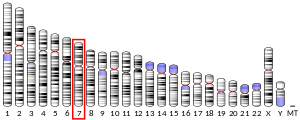From Wikipedia, the free encyclopedia
Protein-coding gene in the species Homo sapiens
Taste receptor type 2 member 5 is a protein that in humans is encoded by the TAS2R5 gene .[ 3]
This gene encodes a bitter taste receptor; bitter taste receptors are members of the G protein-coupled receptor superfamily and are specifically expressed by taste receptor cells of the tongue and palate epithelia. Each of these apparently intronless taste receptor genes encodes a 7-transmembrane receptor protein, functioning as a bitter taste receptor. This gene is clustered with another 3 candidate taste receptor genes on chromosome 7 and is genetically linked to loci that influence bitter perception.[ 3]
Kinnamon SC (2000). "A plethora of taste receptors" . Neuron . 25 (3): 507– 10. doi :10.1016/S0896-6273(00)81054-5 PMID 10774719 . Margolskee RF (2002). "Molecular mechanisms of bitter and sweet taste transduction" . J. Biol. Chem . 277 (1): 1– 4. doi :10.1074/jbc.R100054200 PMID 11696554 . Montmayeur JP, Matsunami H (2002). "Receptors for bitter and sweet taste". Curr. Opin. Neurobiol . 12 (4): 366– 71. doi :10.1016/S0959-4388(02)00345-8 . PMID 12139982 . S2CID 37807140 . Chandrashekar J, Hoon MA, Ryba NJ, Zuker CS (2007). "The receptors and cells for mammalian taste". Nature . 444 (7117): 288– 94. doi :10.1038/nature05401 . PMID 17108952 . S2CID 4431221 . Dias Neto E, Correa RG, Verjovski-Almeida S, Briones MR, Nagai MA, da Silva W, Zago MA, Bordin S, Costa FF, Goldman GH, Carvalho AF, Matsukuma A, Baia GS, Simpson DH, Brunstein A, de Oliveira PS, Bucher P, Jongeneel CV, O'Hare MJ, Soares F, Brentani RR, Reis LF, de Souza SJ, Simpson AJ (2000). "Shotgun sequencing of the human transcriptome with ORF expressed sequence tags" . Proc. Natl. Acad. Sci. U.S.A . 97 (7): 3491– 6. Bibcode :2000PNAS...97.3491D . doi :10.1073/pnas.97.7.3491 PMC 16267 PMID 10737800 . Adler E, Hoon MA, Mueller KL, Chandrashekar J, Ryba NJ, Zuker CS (2000). "A novel family of mammalian taste receptors" . Cell . 100 (6): 693– 702. doi :10.1016/S0092-8674(00)80705-9 PMID 10761934 . S2CID 14604586 . Chandrashekar J, Mueller KL, Hoon MA, Adler E, Feng L, Guo W, Zuker CS, Ryba NJ (2000). "T2Rs function as bitter taste receptors" . Cell . 100 (6): 703– 11. doi :10.1016/S0092-8674(00)80706-0 PMID 10761935 . S2CID 7293493 . Firestein S (2000). "The good taste of genomics" . Nature . 404 (6778): 552– 3. doi :10.1038/35007167 PMID 10766221 . S2CID 35741332 . Matsunami H, Montmayeur JP, Buck LB (2000). "A family of candidate taste receptors in human and mouse". Nature . 404 (6778): 601– 4. Bibcode :2000Natur.404..601M . doi :10.1038/35007072 . PMID 10766242 . S2CID 4336913 . Zhang Y, Hoon MA, Chandrashekar J, Mueller KL, Cook B, Wu D, Zuker CS, Ryba NJ (2003). "Coding of sweet, bitter, and umami tastes: different receptor cells sharing similar signaling pathways" . Cell . 112 (3): 293– 301. doi :10.1016/S0092-8674(03)00071-0 PMID 12581520 . S2CID 718601 . Fischer A, Gilad Y, Man O, Pääbo S (2005). "Evolution of bitter taste receptors in humans and apes" . Mol. Biol. Evol . 22 (3): 432– 6. doi :10.1093/molbev/msi027 PMID 15496549 . Go Y, Satta Y, Takenaka O, Takahata N (2006). "Lineage-specific loss of function of bitter taste receptor genes in humans and nonhuman primates" . Genetics . 170 (1): 313– 26. doi :10.1534/genetics.104.037523 . PMC 1449719 PMID 15744053 .
This article incorporates text from the United States National Library of Medicine , which is in the public domain .


